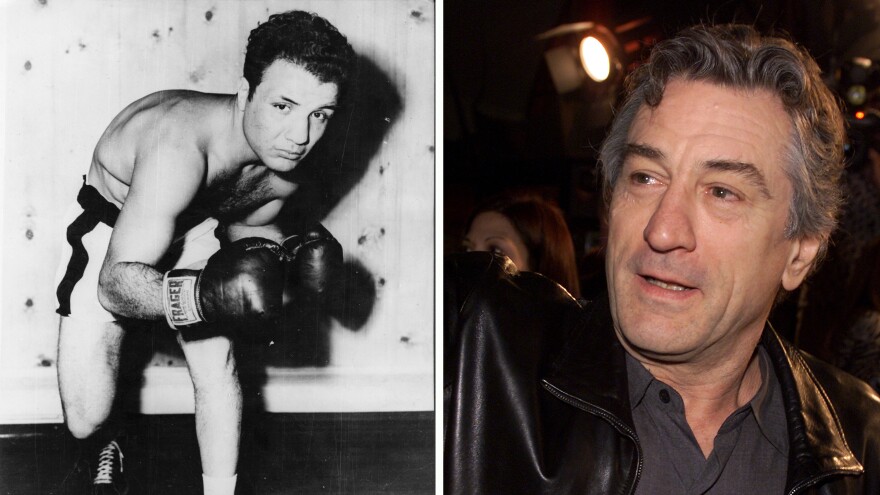Jake LaMotta, the middleweight champion boxer famed for his ferocity in the ring in the 1940s and early '50s, died this week — nearly 40 years after his obituary was written.
That obituary, of course, is Raging Bull.
LaMotta published a memoir of that title in 1970, but it was Martin Scorsese's adaptation of the book, released late in 1980 to critical acclaim and commercial indifference, that became the lasting monument to his life.
Roger Ebert proclaimed it the best American film of the '80s. The American Film Institute's 2007 ranking of the 100 greatest American movies puts Raging Bull at No. 4, behind Citizen Kane, The Godfather and Casablanca. It's often cited as the best boxing film ever made, never mind that it devotes only about 10 percent of its 129-minute running time to fisticuffs, or that two of its primary creators, Scorsese and screenwriter Paul Schrader, resisted star Robert De Niro's overtures to recruit them for the project because they just weren't interested in boxing. That's why they had to make their film about so much more.
Certainly those brutal but undeniably beautiful boxing scenes are Raging Bull's most exotic feature. They make artful use of smoke and varying film speeds andMascagni'sCavalleria Rusticana.Scorsese had cinematographer Michael Chapman position his cameras such that De Niro and his various screen opponents appeared to spar with the viewer — an innovation since copied by many. In these moments, Chapman's crisp black-and-white cinematography and Thelma Schoonmaker's film editing (which won an Oscar) fuse to produce the film's most talked-about set pieces.
But the fighting is secondary to the scenes examining LaMotta jealous, damaged psyche outside the ring. If the film casts his astonishing capacity to absorb physical pain and remain on his feet in the admiring light of a nature documentary, it's far less flattering when it depicts him violently and repeatedly lashing out at his second wife (played by Cathy Moriarty) and his brother Joey (Joe Pesci). (Restoring Joey to the story was Schrader's idea. LaMotta had cut his own brother out of his autobiography, if that tells you anything.)
LaMotta participated in the film's production, personally training De Niro to portray him during his lean and fighting fit years, when LaMotta fought Sugar Ray Robinson a half-dozen times. (He won once, then lost five times; Robinson was best man at LaMotta's sixth wedding.) But LaMotta was still surprised when he sawRaging Bull. He told The New York Times, "I kind of look bad in it."
The middleweight champion of understatement.
"Then I realized it was true."
The middleweight champion of compliments.
Twenty-six years had passed between LaMotta's retirement from the fight game and the release of Raging Bull. He had performed bad stand-up comedy in dodgy nightclubs, which he sometimes owned, and he served time on a chain gang after being convicted of introducing an underage girl to a man at one of his clubs. He pursued a sporadic career as an actor, with minute roles in The Hustler in 1961, but none of these brought him the sort of attention he craved.
Becoming the subject of a cinematic portrait, even a deeply unflattering one of unimpeachable artistic merit, turned out to be a kind of a gift for him.
Nobody imagined that the Bronx Bull and Raging Bull would coexist for almost four decades. He seemed happy to promote the film, even recording a commentary track for its Blu-Ray release. The interviewer prompting him to speak on the track is his nephew Jason Lustig, and their familiarity prompts a shocking level of candor from LaMotta. (There's also the sheer weirdness of hearing an 80-something LaMotta reciting Marlon Brando's "I coulda been a contender" monologue from On the Waterfrontas De Niro's 40-something LaMotta performs it onscreen.)
No one knew it then, but when Raging Bull came along, boxing's long tumble from prominence as a mainstream sport had already begun. Aside from Mike Tyson — who, like LaMotta, would serve time in prison and enjoy an unlikely second career as an entertainer — there would be no one to rival the great heavyweights of decades past. Paradoxically, after Muhammad Ali, boxers could become giants only by allowing us to dissect them.
"You know what's the greatest sin in the world?" LaMotta asks his nephew on theRaging Bullcommentary track. He repeats the question several times before presenting his answer:
"Hurting your fellow man."
Copyright 2021 NPR. To see more, visit https://www.npr.org. 9(MDAxODg3MTg0MDEyMTg2NTY3OTI5YTI3ZA004))



